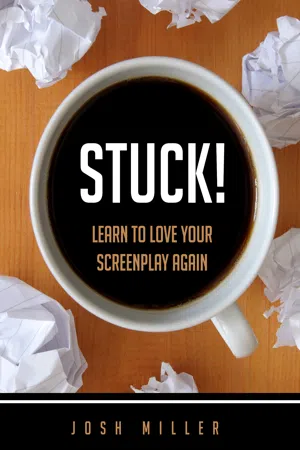
- 288 pages
- English
- ePUB (mobile friendly)
- Available on iOS & Android
About this book
Maybe you have a great idea for a movie, and you're thinking to yourself, "Man, if I only knew how to write a screenplay." Maybe you've started your screenplay already, but you get to a certain point where you JUST DON'T KNOW WHAT TO DO NEXT! Or maybe you've already finished your screenplay, read it over again, hated it, and smashed your hard drive, frustrated. Don't give up on your dreams just yet—not until you've read this book.
Over the course of his successful career as a writer and producer, Josh Miller has learned plenty about the craft and art of screenwriting. There are no fancy tricks or shortcuts to making a great screenplay, just time-honored techniques, fundamental story elements, and one secret ingredient: you. Josh will show you how to create a compelling story and deploy advanced screenwriting techniques, but most importantly, he'll teach you how to harness your unique voice, experience, and perspective to emotionally connect with audiences and give your screenplay real substance. Get this book—and get yourself unstuck.
- Understand visual storytelling elements to tighten up your script and eliminate unnecessary dialogue.
- See effective screenwriting elements in action with instructive examples from more than 200 classic and contemporary films.
- Learn the secrets to creating unforgettable characters that drive the narrative forward and add depth to your story.
- Create effective setups and payoffs to give your story internal logic, yet maintain the element of surprise.
- Master elements of screenwriting craft, such as flashbacks and flash-forwards, time locks, subplots, twists, and more.
Frequently asked questions
- Essential is ideal for learners and professionals who enjoy exploring a wide range of subjects. Access the Essential Library with 800,000+ trusted titles and best-sellers across business, personal growth, and the humanities. Includes unlimited reading time and Standard Read Aloud voice.
- Complete: Perfect for advanced learners and researchers needing full, unrestricted access. Unlock 1.4M+ books across hundreds of subjects, including academic and specialized titles. The Complete Plan also includes advanced features like Premium Read Aloud and Research Assistant.
Please note we cannot support devices running on iOS 13 and Android 7 or earlier. Learn more about using the app.
Information
The Kernel of the Idea
Character
- What is it about this character that fascinates me?
- Why do I think a story about this character will captivate others?
Characters with contradictions
CONTEMPORARY FILM
Matchstick Men
CLASSIC FILMS
Good Will Hunting
Table of contents
- Cover
- Title Page
- Copyright
- Dedication
- Contents
- Author’s Note
- Preface
- Introduction
- How to Use This Book
- 1 The Kernel of the Idea
- 2 The Visual Medium
- 3 Three-Act Dramatic Structure
- 4 Protagonist
- 5 Dominant Character Trait
- 6 Dramatic Objective and Personal Goal
- 7 Antagonist
- 8 Obstacles and Conflict
- 9 Tangible Stakes
- 10 Comedy or Tragedy
- 11 Premise
- 12 Genre
- 13 Conventions vs. Clichés
- 14 Tone and Ground Rules
- 15 Activity vs. Action
- 16 Scene Structure
- 17 Openings
- 18 Setups and Payoffs
- 19 Exposition
- 20 Dialogue and Subtext
- 21 Minor Characters and Crowds
- 22 Flashbacks and Flash-forwards
- 23 Montage and Series of Shots
- 24 Time Transitions
- 25 Counteraction
- 26 Time Locks
- 27 Props and Telephones
- 28 Subplots
- 29 Twists
- 30 Crisis / Black Moment
- 31 Confrontation / Obligatory Scene
- 32 Climax
- 33 Resolution / Denouement
- 34 Emotion
- 35 Practical Advice
- Appendix I: List of Films Discussed
- Appendix II: Standard Screenplay Format
- Appendix III: Glossary
- Acknowledgements
- About the Author